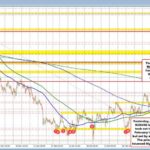
NZDUSD Recovery: Navigating Market Volatility and Future Trends
Tháng 4 8, 2025
Navigating Volatility: S&P 500’s Dramatic Day on April 8, 2025
Tháng 4 8, 2025Evolving Tariff Landscape Under the Trump Administration: What You Need to Know
The ongoing tariff negotiations initiated during the Trump administration have ushered in a complex and evolving trade landscape. Recent developments indicate that the situation remains fluid, with no specific timeline established for the conclusion of tariff negotiations. USTR Greer has confirmed this ongoing process, pointing to a commitment to address tariff-related issues but lacking a definitive roadmap for resolution. This ambiguity suggests that stakeholders should brace themselves for an extended period of uncertainty as discussions continue.
Understanding Recent Tariff Actions and Retaliation
In March and April of 2025, the U.S. government took decisive steps to adjust tariff rates affecting numerous countries. A particularly notable action was the imposition of a 34% tariff on imports from China, scheduled to take effect on April 10. In a swift response, China announced a reciprocal 34% tariff on all U.S.-origin goods, effectively beginning on the same date. This retaliatory strategy underscores the escalating tension between the two economic superpowers, creating a significant ripple effect in global trade dynamics. As discussed in a recent analysis of China’s strategic moves, President Xi Jinping has been actively engaging with global CEOs to address U.S.-China trade tensions and promote international stability, highlighting the importance of collaboration amid these tariff adjustments. For more details, you can read the full summary here.
Moreover, the U.S. has extended its tariff strategy to include reciprocal tariffs with multiple countries, with rates varying between 15% to 46%. Effective April 9, 2025, these tariffs are likely to impact various sectors and exacerbate existing trade tensions. The implications of these moves are profound, as they not only affect the direct trade between the U.S. and targeted nations but also extend their influence on global market stability and trade relationships.
Global Ramifications: An Expanding Sphere of Impact
The recent tariff developments have not only sparked direct retaliation from China but have also triggered economic tensions across a broader international spectrum. Countries such as India, Japan, South Korea, and members of the European Union are feeling the repercussions of these strategic tariff adjustments. The interconnected market systems and trade agreements mean that a singular action by the U.S. can reverberate globally, raising questions about future trade alliances and economic cooperation.
This climate of uncertainty is leading to heightened volatility in global markets. Investors and businesses operating in international spheres must navigate the complexities of fluctuating tariffs and potential countermeasures from affected nations. As trade policies evolve, the potential for additional retaliatory actions remains a looming possibility, further destabilizing existing market conditions.
Conclusion: A Call for Strategic Awareness
In conclusion, the evolving tariff landscape under the Trump administration signifies a pivotal moment in global trade relations. With no clear timeline for negotiations and aggressive tariff implementations leading to reciprocal actions, stakeholders are urged to remain vigilant and adaptive. As the situation unfolds, the focus on strategic awareness will be paramount for businesses and investors alike. Understanding the intricate web of international trade relations and being prepared for change will be essential in an increasingly unpredictable economic environment.

